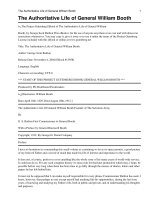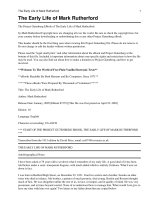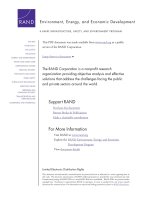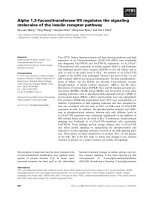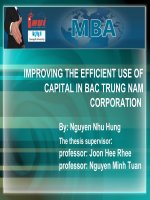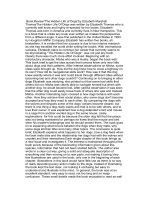vii improving the fatigue life of weldments
Bạn đang xem bản rút gọn của tài liệu. Xem và tải ngay bản đầy đủ của tài liệu tại đây (4.71 MB, 48 trang )
AM 11/03 1
VII Improving the fatigue
life of weldments
AM 11/03 2
Outline
n Obvious things to do
n Problems the weld toe
n Fatigue life Improvement Strategies
n Light and heavy industry weldments
n Improving the “bad” weldments
AM 11/03 3
Crude! (bad)
AM 11/03 4
Better
AM 11/03 5
Bad - planar weld discontinuities
AM 11/03 6
Outline
n Obvious things to do
n Problems the weld toe
n Fatigue life Improvement Strategies
n Light and heavy industry weldments
n Improving the “bad” weldments
AM 11/03 7
Weld toe is a stress concentration
AM 11/03 8
Slag entrapments at toe?
Virtually
eliminates
fatigue
crack
initiation
life NI
AM 11/03 9
Welding procedure A
Welding procedure B
Cold-lap defects at weld toe
Cold laps virtually eliminate the
fatigue crack initiation life (NI)
Such weldments may have
an appreciable fatigue crack
initiation life (NI)
“Nominal”
“Perfect”
AM 11/03 10
Cold lap at a weld toe
Loading
Direction
D
Weld Metal
Base Metal
Heat Affected Zone
Weld Toe Location
Without Cold-Lap Defect
Curved Path
Vertical Path
θ
r
φ
AM 11/03 11
Effect of cold lap depth
1
10
0.001 0.01 0.1
D = 0.0 mm, M
K CG
, curved path from
weld toe location
D = 1.0 mm, M
K CG
, curved path from
cold-lap defect
D = 1.0 mm, M
K CG
, vertical path from
cold-lap defect
K
Crack length / main plate thickness, (a/T)
2-D FEM
Weld geometry correction factor, M
K
AM 11/03 12
Effect of flank angle
1
10
0.001 0.01 0.1
θ = 30
o
θ = 45
o
θ = 60
o
K
Crack length / main plate thickness, (a/T)
2-D FEM
D = 1.0 mm
Weld geometry correction factor, M
K
AM 11/03 13
Effect of cold root radius
1
10
0.001 0.01 0.1
D = 0.00 mm, weld toe location
D = 2.00 mm, r
cl
= 0.146 mm
D = 2.00 mm, r
cl
= 0.025 mm
K
Crack length / main plate thickness, (a/T)
Weld geometry correction factor, M
K
AM 11/03 14
Recent study on rail welds
Toe Radius, R
Weld
Reinforcement
Height, H
Base Metal
Thickness, T
b
Weld Collar
Width, W
Flank
Angle, θ
AM 11/03 15
Geometric Parameters
Fin Length, L
f
Cold Lap
Length, L
cl
Fin Thickness,
T
f
Flank
Angle, θ
AM 11/03 16
Weld with a Fin and a Cold Lap
AM 11/03 17
Deformed Shape
AM 11/03 18
Nominal Weld Geometry
1
1.5
2
2.5
3
3.5
4
4.5
0 10 20 30 40 50 60 70 80 90
Flank Angle, θ (Deg.)
R=.5mm
R=1mm
R=3mm
R=6mm
AM 11/03 19
1
2
3
4
5
6
7
0 2 4 6 8 10 12 14
Fin Length, Lf (mm)
Elastic Stress Concentration Factor, Kt (-)
Fin Thickness = .5mm
Fin Thickness=1mm
Fin Thickness=2mm
Fin length
AM 11/03 20
Fins and Cold Laps
1
2
3
4
5
6
7
-4 -2 0 2 4 6 8
Cold Lap Length, L
cl
(mm)
Cold Lap; NO Fin
Cold Lap with Fin 0.5 mm Thick
Cold Lap with Fin 1 mm Thick
Cold Lap with Fin 2 mm Thick
Defect Free
For All Tests
R=3mm and
θ=30°
AM 11/03 21
Trends in “Ideal”
1.0-in plate
thickness, non-load
carrying cruciform
weldments fatigue
strength.
• R = 0
• Welding residual
stresses = 50% of
S
YBM
• S
fab
˜ S
YBM
Predicted effect of S
uBM
0
10
20
30
40
50
60
0 50 100 150 200
Fatigue Strength at 1E+07 cycles, Sa (ksi)
Base Metal Ultimate Strength, Su
BM
(ksi)
As Welded, S
fab
= 0
As Welded, S
fab
= Sy
BM
Over Stressed
Hot Rolled Steel
Q & T Steel
Stress Relieved
AM 11/03 22
Outline
n Obvious things to do
n Problems the weld toe
n Fatigue life Improvement
Strategies
n Light and heavy industry weldments
n Improving the “bad” weldments
AM 11/03 23
Good - grind off reinforcement
AM 11/03 24
Good - burr grind weld toe
AM 11/03 25
Very good - full face grinding
